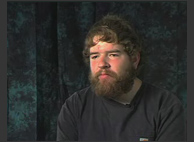| NIMH: Autism Spectrum Disorders | |
| NICHD: Autism and the MMR Vaccine | |
| Richard, Age 52 | |
| Jeff, Age 35 | |
| NIMH: Autism Spectrum Disorders (pdf) | |
| CDC: Learn the Signs Information Card (pdf) | |

National Institute of Child Health & Human Development
Autism and the MMR Vaccine
Is there any research going on to find out if the MMR vaccine is linked to autism?
The NIH is doing a number of things to look into the claims about MMR vaccines and autism:
- The Network on the Neurobiology and Genetics of Autism: Collaborative Programs of Excellence in Autism (CPEA), funded by the NICHD and the National Institute on Deafness and Other Communication Disorders (NIDCD), with additional funding from the CDC, are working together to study autism and the MMR vaccine.This research will examine people diagnosed with autism who seemed to develop normally, but then started to show autistic symptoms.This type of situation is called “regression.”To learn as much as possible about these patients, researchers will compare them to people who do not have autism, and to people who showed autistic symptoms since birth, called classic autism.CPEA researchers will compare vaccination records to see if the onset of autism was associated with receipt of MMR and other vaccines.Lab tests will then look for any evidence of persistent infections that could be related to the MMR vaccine.
- The NICHD is also working with other NIH Institutes, the CDC, the Environmental Protection Agency (EPA), and other federal agencies to conduct a large, long-term study of the effects of the environment on children’s health.This study will follow 100,000 children from before birth to age 20, to track their growth and development, as well as their genetic blueprints and environmental factors that they encounter.Researchers hope to establish or rule out links between a variety of environmental events and normal and abnormal development, such as autism, asthma, and other childhood disorders that have shown dramatic increase.The study is currently under design.
- Another NIH Institute, the National Institute of Neurological Disorders and Stroke (NINDS) is also conducting a retrospective case-control study to identify any molecular markers in neonatal blood of children with autism, with support from the California Department of Health Services and the Division of Bioengineering and Physical Science (DBEPS) at the NIH.
- In 1998, the NIH, led by the NICHD and the NINDS, sponsored a conference on ASDs.These and other NIH Institutes formed an expert panel, which also included 15 professional organizations and three parents’ groups, and began a review of over 2,500 scientific articles to develop a system for diagnosing ASDs.The panel published its findings in the Journal of Autism and Developmental Disorders in 1999 (Filipek et al 1999).In 2000, the panel’s report was adopted as a practice parameter by the American Academy of Neurology and the Child Neurology Society (Filipek et al 2000). Practice parameter: screening and diagnosis of autism gives doctors and other health professionals the first, standardized method for diagnosing autism and ASDs based on scientific evidence.
In addition, the NIH is in the process of implementing the autism aspects of the Children’s Health Act of 2000.This Act, which was signed into law in October 2000, charges the NIH with the, “Expansion, intensification, and coordination of activities of the NIH with respect to research on autism.”All of the NIH Institutes that fund autism research are working together to establish “Centers of Excellence” to focus on autism research.In addition, the NIH will form a committee with representatives from parents’ groups and other federal agencies to coordinate autism research activities throughout the federal government and to enhance efforts to educate doctors and other health care professionals, and parents, and other child caretakers, about autism.
NICHD
Last Update: 08/15/2006



